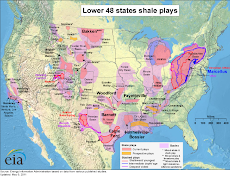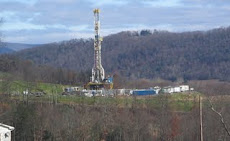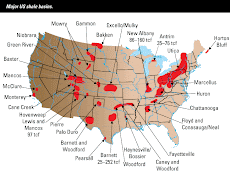CADDO PARISH, La. -- A massive natural-gas discovery here in northern Louisiana heralds a big shift in the nation's energy landscape. After an era of declining production, the U.S. is now swimming in natural gas.
Even conservative estimates suggest the Louisiana discovery -- known as the Haynesville Shale, for the dense rock formation that contains the gas -- could hold some 200 trillion cubic feet of natural gas. That's the equivalent of 33 billion barrels of oil, or 18 years' worth of current U.S. oil production. Some industry executives think the field could be several times that size.
"There's no dry hole here," says Joan Dunlap, vice president of Petrohawk Energy Corp., standing beside a drilling rig near a former Shreveport amusement park.
Huge new fields also have been found in Texas, Arkansas and Pennsylvania. One industry-backed study estimates the U.S. has more than 2,200 trillion cubic feet of gas waiting to be pumped, enough to satisfy nearly 100 years of current U.S. natural-gas demand.
The discoveries have spurred energy experts and policy makers to start looking to natural gas in their pursuit of a wide range of goals: easing the impact of energy-price spikes, reducing dependence on foreign oil, lowering "greenhouse gas" emissions and speeding the transition to renewable fuels.
A climate-change bill being pushed by President Barack Obama could boost reliance on natural gas. The bill, which could emerge from the House Energy and Commerce Committee in May, is expected to set aggressive targets for reducing emissions of carbon dioxide, the most prevalent man-made greenhouse gas.
Meeting such goals would require quickly moving away from coal-fired power plants, which account for substantial carbon emissions. President Obama wants the U.S. to rely more on renewable energy such as wind and solar power, but those technologies aren't ready to shoulder more than a fraction of the nation's energy burden. Advocates for natural gas argue that the fuel, which is cleaner than coal, would be a logical quick fix. In addition, billionaire energy investor T. Boone Pickens has been touting natural gas as an alternative to gasoline and diesel for cars and trucks.
"The availability of natural-gas generation enables us to be much more courageous in charting a transition to a low-carbon economy," says Jason Grumet, executive director of the National Commission on Energy Policy, who was a senior adviser to President Obama during the campaign.
Just three years ago, the conventional wisdom was that U.S. natural-gas production was facing permanent decline. U.S. policy makers were resigned to the idea that the country would have to rely more on foreign imports to supply the fuel that heats half of American homes, generates one-fifth of the nation's electricity, and is a key component in plastics, chemicals and fertilizer.
But new technologies and a drilling boom have helped production rise 11% in the past two years. Now there's a glut, which has driven prices down to a six-year low and prompted producers to temporarily cut back drilling and search for new demand.
The natural-gas discoveries come as oil has become harder to find and more expensive to produce. The U.S. is increasingly reliant on supplies imported from the Middle East and other politically unstable regions. In contrast, 98% of the natural gas consumed in the U.S. is produced in North America.
Coal remains plentiful in the U.S., but is likely to face new restrictions. To produce the same amount of energy, burning gas emits about half as much carbon dioxide as burning coal.
Natural gas has never played more than a supporting role in the nation's energy supply. Crude oil, refined into gasoline or diesel, fuels nearly all U.S. cars or trucks. Coal is the dominant fuel for generating electricity.
Natural-gas production in the U.S. peaked in the early 1970s, then fell for a decade due to weak prices and declining gas fields in Texas, Louisiana and elsewhere. Production bounced back in the 1990s with the discovery of new fields in New Mexico and Wyoming, but by 2002, output was falling again -- this time, most experts thought, for good. Believing the U.S. would soon need to import liquefied natural gas from overseas, companies such as ConocoPhillips, El Paso Corp. and Cheniere Energy Inc. spent billions on terminals, pipelines and storage facilities.
The supply fears drove up prices, which spurred innovation. Oil-and-gas companies had known for decades that there was gas trapped in shale, a nonporous rock common in much of the U.S. but considered too dense to produce much gas.
In the 1980s, Texas oilman George Mitchell began trying to produce gas from a formation near Fort Worth, Texas, known as the Barnett Shale. He pumped millions of gallons of water at high pressure down the well, cracking open the rock and allowing gas to flow to the surface.
Oklahoma City-based Devon Energy Corp. bought Mr. Mitchell's company in 2002. It combined his methods with a technique for drilling straight down to gas-bearing rock, then turning horizontally to stay within the formation. Devon's first horizontal wells produced about three times as much gas as traditional vertical wells.
The development of the Barnett Shale almost single-handedly reversed the decline in U.S. natural-gas production. Last year, the Barnett produced four billion cubic feet of gas a day, making it the largest field in the U.S. Other companies such as Newfield Exploration Co., Southwestern Energy Co. and Range Resources Corp. found shale fields across the U.S.
One of the most aggressive companies was Oklahoma City-based Chesapeake Energy Corp., which got into the Barnett a couple of years behind cross-town rival Devon, and was an early entrant into the second big U.S. field, the Fayetteville Shale in Arkansas. In 2005, Chesapeake Chief Executive Aubrey McClendon sent teams of geologists across the country with a mission: Find the next Barnett. Less than two years later, they told him they had it, in Louisiana.
The Haynesville Shale is centered in northern Louisiana, one of the country's oldest oil- and gas-producing regions. Wildcatters had explored beneath the lush cow pastures and cotton fields as far back as the 1870s. Shreveport, the region's largest city, saw decades of booms and busts until the 1980s, when a glut of cheap oil from overseas all but killed the region's oil industry.
Oil companies knew about the Haynesville Shale, but it was considered a less viable prospect than the Barnett. The shale lies 10,000 or more feet below ground, where high pressure and 300-degree temperatures are enough to fry high-tech drilling equipment.
But in 2006, Chesapeake drilled an exploratory well and decided the results were promising enough to justify the higher cost of drilling in such harsh conditions. By late 2007, Mr. McClendon says, "we knew that we had a tiger by the tail."
In March 2008, as oil and gas prices were soaring, Chesapeake went public with its findings. The rush was on: Dozens of companies dispatched agents to the area to lease land for drilling, turning farmers and ranchers into millionaires overnight.
"There was excitement in the air," recalls Jeffrey Wellborn, a Shreveport resident who sits on the board of the local Sierra Club. "You thought everyone in the world had won the lottery."
The frenzy marked the peak of a nationwide drilling boom that was fueled by a combination of soaring energy prices and easy credit. It didn't last. Between July and October, oil and gas prices fell by more than 50%, and kept falling.
The weakening economy eroded demand for both oil and gas. Natural gas, unlike oil, suffered from a supply glut. U.S. gas production rose 7.2% last year, while oil production fell 1.9%. As a result, oil prices are up 12% since the start of 2009. Natural-gas prices have fallen 41% to their lowest since 2002.
Gas producers saw their profits evaporate and share prices slump. Liquefied-natural-gas imports plunged, leaving import terminals nearly idle. Worried about a glut, companies cut back sharply on drilling and formed a lobbying group to try to boost demand.
The growing supply created opportunities for policy makers and environmentalists, who saw natural gas as a possible solution to the nation's energy problems. Some groups suggested burning more gas and less coal for power generation. Others favor its use in vehicles.
Mr. Pickens has spent millions promoting an energy plan that aims to, among other things, convert thousands of big-rig trucks to run on natural gas. Mr. Pickens has large investments in natural gas and stands to benefit if his plan is adopted. In TV ads, Internet videos and speeches, he emphasizes a different goal: reducing U.S. dependence on foreign oil.
Mr. Pickens arrived for a recent speech in Dallas in a natural-gas-fueled Honda Civic with a bright blue "Pickens Plan" logo. He told a packed auditorium that the U.S. is importing two-thirds of its oil even as the country is "absolutely overwhelmed with natural gas." If the reverse were true, he said, he would favor burning oil.
Some environmentalists have embraced Mr. Pickens's plan as a way to fight climate change. Carl Pope, executive director of the Sierra Club, says he sees natural gas as a "bridge fuel" that could help the U.S. burn less coal and oil until renewable sources of energy are ready to take over.
The dual message of energy security and environmental responsibility has helped Mr. Pickens win powerful allies, including Senate Majority Leader Harry Reid, House Speaker Nancy Pelosi and dozens of elected officials from both parties. A bipartisan bill providing tax incentives for natural-gas cars looks likely to pass this year.
Not everyone shares Mr. Pickens's enthusiasm for natural-gas vehicles. Major users of natural gas, such as utilities and chemicals companies, are concerned the plan would drive up prices -- an outcome that would benefit producers.
Energy Secretary Steven Chu and some other policy makers have expressed doubts about the practicality of retrofitting hundreds of thousands of service stations to offer natural gas. Some environmental groups, including the Natural Resources Defense Council, have argued that natural gas is better used to replace coal for power generation, and that cars should run on electricity generated by the sun, wind and natural gas.
Market forces are already helping natural gas make inroads against coal and oil. Gas is now cheaper than coal in many parts of the country, leading utilities to burn more gas. Of the 372 power plants expected to be built in the U.S. over the next three years, 206 will be fired by gas and just 31 by coal, according to the Energy Information Administration.
Natural gas is gaining market share far more slowly in transportation. Earlier this year, AT&T announced it would convert up to 20% of its truck fleet to run on natural gas, largely because it has been cheaper than gasoline in recent years. Cities including New York, Los Angeles and Atlanta have converted part of their bus fleets to run on natural gas, for air-quality reasons.
Shreveport could be the next city to make the switch. In March, Mayor Cedric Glover announced that the oil capital turned natural-gas boomtown would abandon diesel and convert its bus fleet to natural gas.
 "Although coal-fired plants produce a lot of carbon dioxide, banning them alone won't curb climate change". Photo credit
"Although coal-fired plants produce a lot of carbon dioxide, banning them alone won't curb climate change". Photo credit 
![[U.S. Gas Fields Go From Bust to Boom]](http://s.wsj.net/public/resources/images/P1-AP715A_NATGA_NS_20090429185625.gif)
![[U.S. Gas Fields Go From Bust to Boom]](http://s.wsj.net/public/resources/images/P1-AP716B_NATGA_NS_20090429185643.gif)


